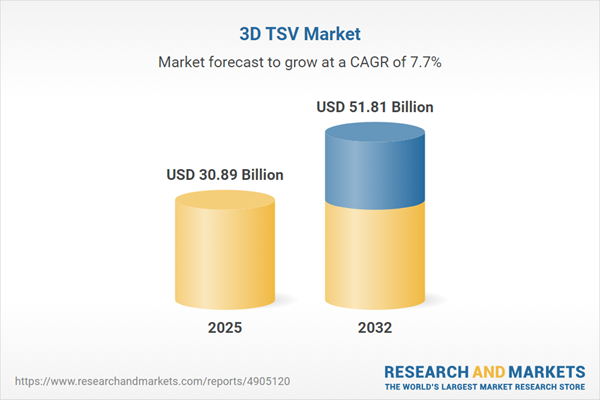Speak directly to the analyst to clarify any post sales queries you may have.
The three dimensional through silicon via (3D TSV) market is experiencing steady advancement, driven by a convergence of miniaturization needs, performance enhancement, and cross-industry adoption. As modern semiconductor demands intensify, business leaders must stay informed on integration breakthroughs shaping the competitive landscape.
Market Snapshot: 3D TSV Market Size and Growth
The 3D TSV Market grew from USD 28.68 billion in 2024 to USD 30.89 billion in 2025. It is expected to continue expanding at a CAGR of 7.67%, reaching USD 51.81 billion by 2032. This robust growth signals a shift toward the mainstream adoption of advanced vertical interconnect technologies, underscoring the role of three dimensional through silicon via as an essential enabler in next-generation semiconductor devices.
Scope & Segmentation
This report provides comprehensive analysis of market dynamics, trends, and segment-specific developments in the 3D TSV landscape across key geographic and application domains. Detailed segmentation covers:
- TSV Material Type: Copper, Tungsten
- Wafer Size: 200 Mm, 300 Mm
- Packaging Type: 2.5D, 3D
- Application: CMOS Image Sensor, Logic (CPU, GPU), Memory (DRAM, NAND Flash)
- End User Industry: Automotive (ADAS, Infotainment), Consumer Electronics (PCs & Laptops, Smartphones, Tablets), Healthcare (Diagnostics, Imaging), Information Communication Technology (Networking Equipment, Servers)
- Geographic Regions: North America (United States, Canada, Mexico), Latin America (Brazil, Argentina, Chile, Colombia, Peru), Europe (United Kingdom, Germany, France, Russia, Italy, Spain, Netherlands, Sweden, Poland, Switzerland), Middle East (United Arab Emirates, Saudi Arabia, Qatar, Turkey, Israel), Africa (South Africa, Nigeria, Egypt, Kenya), Asia-Pacific (China, India, Japan, Australia, South Korea, Indonesia, Thailand, Malaysia, Singapore, Taiwan)
- Key Companies: Taiwan Semiconductor Manufacturing Company Limited, Samsung Electronics Co., Ltd., ASE Technology Holding, Co., Ltd., SK Hynix Inc., Amkor Technology, Inc., Yole Group, EMK Technologies Pte Ltd., Powertech Technology Inc., Synopsys, Inc., UTAC Holdings Ltd.
Key Takeaways
- 3D TSV technology is unlocking new performance benchmarks by enabling higher component density and energy efficiency in both high performance computing and miniaturized consumer devices.
- Material selection—primarily between copper and tungsten—directly impacts electrical performance, via reliability, and downstream manufacturing choices.
- The shift toward larger wafer sizes supports economies of scale, though niche applications still leverage mature 200 mm processes to balance cost and specialized throughput needs.
- Cross-industry collaboration involving design houses, foundries, and packaging specialists is accelerating innovation in TSV fabrication, including advances in lithography, metallization, and hybrid materials.
- Strategic partnerships and capacity investments are influencing global supply chains, while corporate consolidations are helping established companies secure specialized TSV expertise.
Tariff Impact
Recent United States trade policies have imposed new tariffs on critical semiconductor components, prompting organizations to adapt sourcing and procurement strategies. The resulting shifts include regional diversification, adoption of dual sourcing models, and enhanced collaboration with equipment vendors to reduce tariff exposure. Companies are integrating alternate materials and process controls to sustain technological progress while responding to regulatory pressures and evolving cross-border supply chain risks.
Methodology & Data Sources
This report applies an integrated approach, combining expert consultations with semiconductor engineers, packaging architects, and supply chain executives alongside systematic reviews of academic, regulatory, and industry sources. All data points were validated through triangulation and independent corroboration to ensure credible, actionable insights.
Why This Report Matters
- Equips senior decision-makers with a clear perspective on leveraging 3D TSV capabilities for resilient supply chains, faster product launches, and robust differentiation.
- Offers actionable recommendations for supply network optimization, material and process qualification, and strategic risk management amid ongoing sector disruptions.
- Enables informed investment and R&D planning in response to shifting market, regulatory, and partnership dynamics.
Conclusion
As three dimensional TSV technology scales from pilot phases to mainstream manufacturing, proactive alignment of strategic, technical, and operational priorities is essential. This research empowers business leaders to navigate complexity and capture emerging opportunities in the evolving semiconductor integration landscape.
Additional Product Information:
- Purchase of this report includes 1 year online access with quarterly updates.
- This report can be updated on request. Please contact our Customer Experience team using the Ask a Question widget on our website.
Table of Contents
3. Executive Summary
4. Market Overview
7. Cumulative Impact of Artificial Intelligence 2025
Companies Mentioned
The companies profiled in this 3D TSV market report include:- Taiwan Semiconductor Manufacturing Company Limited
- Samsung Electronics Co., Ltd.
- ASE Technology Holding, Co., Ltd.
- SK Hynix Inc.
- Amkor Technology, Inc.
- Yole Group
- EMK Technologies Pte Ltd.
- Powertech Technology Inc.
- Synopsys, Inc.
- UTAC Holdings Ltd.
Table Information
| Report Attribute | Details |
|---|---|
| No. of Pages | 195 |
| Published | October 2025 |
| Forecast Period | 2025 - 2032 |
| Estimated Market Value ( USD | $ 30.89 Billion |
| Forecasted Market Value ( USD | $ 51.81 Billion |
| Compound Annual Growth Rate | 7.6% |
| Regions Covered | Global |
| No. of Companies Mentioned | 11 |









